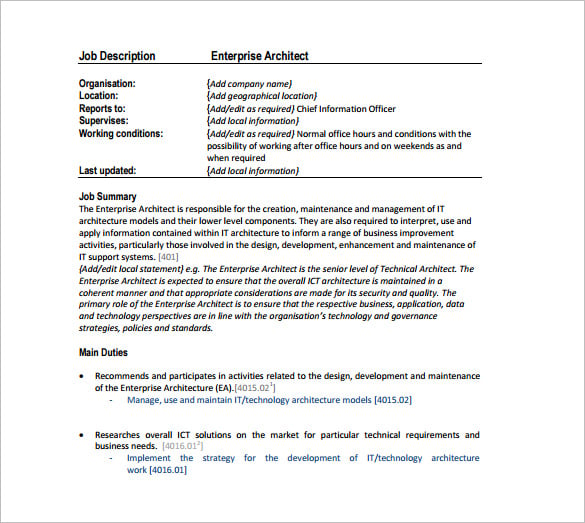


Later, the roles of architects and engineers became separated. During the European Middle Ages, pan-European styles of Romanesque and Gothic cathedrals and abbeys emerged while the Renaissance favored Classical forms implemented by architects known by name. Indian and Chinese architecture influenced forms all over Asia and Buddhist architecture in particular took diverse local flavors. Ancient urban architecture was preoccupied with building religious structures and buildings symbolizing the political power of rulers until Greek and Roman architecture shifted focus to civic virtues.
#Chief architect job description trial
The idea of sustainable architecture was introduced in the late 20th century.Īrchitecture began as rural, oral vernacular architecture that developed from trial and error to successful replication. "Function" began to replace the classical "utility" and was understood to include not only practical but also aesthetic, psychological and cultural dimensions. In the 19th century, Louis Sullivan declared that " form follows function". Giorgio Vasari wrote Lives of the Most Excellent Painters, Sculptors, and Architects and put forward the idea of style in the Western arts in the 16th century.

Centuries later, Leon Battista Alberti developed his ideas further, seeing beauty as an objective quality of buildings to be found in their proportions.

The earliest surviving text on architectural theory is the 1st century AD treatise De architectura by the Roman architect Vitruvius, according to whom a good building embodies firmitas, utilitas, and venustas (durability, utility, and beauty). Texts on architecture have been written since ancient time. For this reason, architecture is considered to be a form of art. The practice, which began in the prehistoric era, has been used as a way of expressing culture for civilizations on all seven continents. Historical civilizations are often identified with their surviving architectural achievements. Architectural works, in the material form of buildings, are often perceived as cultural symbols and as works of art. Īrchitecture (Latin architectura, from the Greek ἀρχιτέκτων arkhitekton "architect", from ἀρχι- "chief" and τέκτων "creator") is both the process and the product of planning, designing, and constructing buildings or other structures. In adding the dome to the Florence Cathedral (Italy) in the early 15th century, the architect Filippo Brunelleschi not only transformed the building and the city, but also the role and status of the architect.


 0 kommentar(er)
0 kommentar(er)
